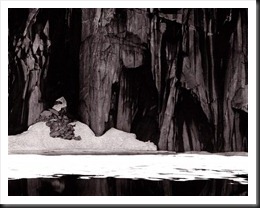It was in the ‘70s when I was backpacking through the Kaweah Gap areas of the Sierra Nevada mountains. We were two days out and came upon this lake. I instantly recognized it from on of Ansel Adams that I particularly liked – Precipice Lake. It was exciting and we spent the night there.
I’ve always been a fan of this Ansel Adams classic. For me it has a feeling of immensity and majesty. So it has a special meaning to me reading about it in “Examples.” A few things caught my attention in Adams’ narrative…
For one, it recalled the days of film photography where we didn’t have light meters and guessed at the exposures. Such was the case when Adams took this photograph in 1932. He hadn’t yet developed the Zone System which would have guaranteed a perfect negative. So he underexposed a ‘normal’ exposure by one stop but the shadowy cliffs were still underexposed and the ice on the lake way overexposed. To make matters worse, when he developed the negative he didn’t use fresh developer so the negative was nearly ruined. It wasn’t until the 1970s that he finally had the right paper and techniques to reproduce the feeling of awe that inspired him to trip the shutter.
Adams refers to Group f/64 in the narrative. Group f/64 was formed by a small group of Western photographers to counter Pictorialism that was the predominant approach of the time to “photography as art.” One characteristic of Pictorialism was soft images. Also, Pictorialism combined painting and photographic techniques, subscribing to a commonly held opinion that photography on its own could not be art. Group f/64 took the opposite stance – that photographs should be sharp throughout (hence the f/64 in the group’s name, the aperture setting that ensured maximum depth of field), exploit the full tonal range of the medium and, most importantly, photography in and of itself could be art.
Regarding what must have been a non-traditional composition for its time, Adams said, “Many speak of this image as being abstract, but I was not conscious of any such definition at the time. I prefer the term extract over abstract,…. For photographic compositions I think in terms of creating configurations out of chaos, rather than following any conventional rules of composition.” He then goes on to quote Edward Weston, a personal friend and fellow Group f/64 member, “composition is the strongest way of seeing.” The important thing is his composition expressed “the monumental qualities of the subject that I responded to so intensely at first sight.”
Adams wasn’t the only photographer standing there on the shore of Precipice Lake that fine day. But he was the only one that saw this composition. He touches on one of the things that makes fine art photography so fascinating and so personal. “I am interested in why I see certain events in the world about me that others do not see, while they respond to different events.” I see this all the time at workshops. You have a dozen or so people photographing the same location and later when we review the photographs each has his or her own unique and very personal vision.
“With all art expression, when something is seen, it is a vivid experience, sudden, compelling, and inevitable. The visualization is complete, the seemingly instant review of all the mental and imaginative resources called forth by some miracle of the mind-computer that we do not comprehend, For me this resource is not of things consciously seen or transcriptions of musical recollections; it is, perhaps, a summation of total experience and instinct. Nothing modifies or replaces it.”
This is part of a continuing series on Ansel Adam’s wonderful book “Examples – The Making of 40 Photographs.” Don’t miss any more posts. Scroll to “Subscribe to Blog via Email” on the right and enter your email address. We will keep it strictly confidential.
Here are some of the previous posts.
Ansel Adams – The Making of 40 Photographs
Join me on an upcoming workshop. Click here for more details.
To see more of my photographs click here.
WordPress Tags: Ansel,Adams,Frozen,Lake,photography,System,exposure,paper,Group,narrative,Western,Pictorialism,images,Also,opinion,stance,aperture,depth,composition,Many,image,definition,chaos,rules,Edward,Weston,friend,member,qualities,subject,Precipice,events,world,location,vision,visualization,miracle,computer,resource,recollections,summation,instinct,Cliffs,meters,exposures,techniques,compositions,transcriptions,didn’t,wasn’t
(2032)

